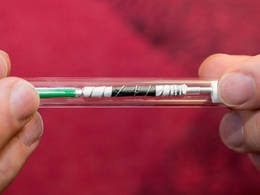May 6 2016
Rechargeable lithium air batteries are considered an advanced technology. At a theoretical level, these batteries may deliver better performance and could be relatively lighter than existing lithium-ion batteries, but they stop working after several charging cycles.
 Corresponding author Johannes Wandt with one of the electron paramagnetic resonance probes he developed - Photo: Andreas Battenberg / TUM
Corresponding author Johannes Wandt with one of the electron paramagnetic resonance probes he developed - Photo: Andreas Battenberg / TUM
To address this issue, scientists from the Technical University of Munich (TUM) and the Forschungszentrum Jülich studied the processes and eventually discovered that a highly reactive substance called singlet oxygen is the reason behind this limitation. Whenever lithium air batteries are charged, it results in the emission of singlet oxygen.
Laptop PCs continue to strain shoulder muscles, and cellular phones still protrude from jacket pockets. Lithium ion batteries can be blamed for such effects, as they require heavy electrodes that are made from transition metal oxides. So researchers continue to look for better and light-weight alternatives.
One of the most promising approaches is the lithium air battery in which the lithium cobalt oxide cathode is replaced by carbon particles. The theoretical energy density of these new rechargeable batteries is significantly higher than that of traditional lithium ion batteries; The problem was that no one knew exactly why.
Johannes Wandt, Doctoral Candidate, Department of Technical Electrochemistry, TUM
Regrettably, the technology is still not ready for daily applications as such batteries tend to have a limited lifespan. Just a few charging cycles results in corrosion of the carbon electrode and decomposition of the electrolytic fluid.
The Mystery of the Short Battery Life
Wandt and his colleagues have now resolved the mystery. The Munich scientists, with experts from the Forschungszentrum Jülich, performed an experiment where they discovered a potential problem for the decomposing electrodes and electrolytic fluid: the highly reactive singlet oxygen is produced on charging lithium air batteries. When this substance comes into contact with the surrounding material, it causes corrosion within a matter of seconds. While there had been a long-held suspicion that singlet oxygen affects batteries, it was only now that the research team discovered the presence of this highly reactive substance. This raises the question as to why it took so long to make that discovery.
Simply put, no one bothered to look for it.
Johannes Wandt, Doctoral Candidate, Department of Technical Electrochemistry, TUM
Due to a miscalculation, researchers naturally assumed that the fundamental reaction only takes place at high voltages. The situation was further worsened by a complicated experimental setup.
Two Years of Fiddling
To explore the charging process in a better way, the TUM team developed a unique kind of lithium air battery, where the power sinks are very thin and organized in a helix form within a see-through glass housing. This set up helped to ensure that magnetic fields and microwave radiation required for the measurements are not protected.
In addition, we added molecules to the electrolytic fluid that capture the short-lived singlet oxygen and bond it as a stable radical. Using a special measuring instrument in Jülich for electron paramagnetic resonance spectroscopy, or EPR, we were able to substantiate the formation of singlet oxygen during the charging process.
Johannes Wandt, Doctoral Candidate, Department of Technical Electrochemistry, TUM
The problem has thus been identified – but not averted. The team is now hoping to discover a mechanism that can help eliminate the formation of singlet oxygen during the charging process.
Basic research could provide the foundation for the development of novel, long-lasting lithium air batteries.
Johannes Wandt, Doctoral Candidate, Department of Technical Electrochemistry, TUM
The study was supported by the German Federal Ministry of Education and Research (BMBF) within the framework of the project Materials and components for batteries with high energy density (MEET HiEnd) and the Bavarian Ministry of Economic Affairs and Media, Energy and Technology under the EEBatt project, which is part of the interdisciplinary research initiative TUM.Energy of the Munich School of Engineering.